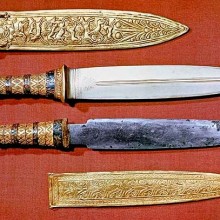| Topic: King Tut's Blade Made of Meteorite | |
|---|---|

King Tut's Blade Made of Meteorite Credit: Daniela Comelli King Tut was buried with a dagger made of an iron that literally came from space, says a new study into the composition of the iron blade from the sarcophagus of the boy king. Using non-invasive, portable X-ray fluorescence spectrometry, a team of Italian and Egyptian researchers confirmed that the iron of the dagger placed on the right thigh of King Tut's mummified body a has meteoric origin. The team, which include researchers from Milan Polytechnic, Pisa University and the Egyptian Museum in Cairo, detailed their results in the journal Meteoritics and Planetary Science. The weapon, now on display at the Egyptian Museum in Cairo, was described in 1925 by Howard Carter, who three years before had discovered the treasure-packed tomb, as "a highly ornamented gold dagger with crystal knob." Made of non-rusted, homogeneous metal, the finely manufactured blade features a decorated gold handle. It is completed by a gold sheath garnished with a floral lily motif on one side and with a feathers pattern on the other side, terminating with a jackal's head. Now dramatic technological improvements have allowed the researchers to determine the composition of the blade. "Meteoric iron is clearly indicated by the presence of a high percentages of nickel," main author Daniela Comelli, at the department of Physics of Milan Polytechnic, told Discovery News. Indeed, iron meteorites are mostly made of iron and nickel, with minor quantities of cobalt, phosphorus , sulfur and carbon. While artifacts produced with iron ore quarrying display 4 percent of nickel at most, the iron blade of King Tut's dagger was found to contain nearly 11 percent of nickel. Further confirmation of the blade's meteoric origin came from cobalt traces. "The nickel and cobalt ratio in the dagger blade is consistent with that of iron meteorites that have preserved the primitive chondritic ratio during planetary differentiation in the early solar system," Comelli said. Comelli and colleagues also investigated the possible source of the iron blade. "We took into consideration all meteorites found within an area of 2,000 km in radius centered in the Red Sea, and we ended up with 20 iron meteorites," Comelli said. "Only one, named Kharga, turned out to have nickel and cobalt contents which are possibly consistent with the composition of the blade," she added. The meteorite fragment was found in 2000 on a limestone plateau at Mersa Matruh, a seaport some 150 miles west of Alexandria. RELATED: Who Else May Be in King Tut's Tomb? The study shows the ancient Egyptians attributed great value to meteoritic iron for the production of precious objects, possibly perceiving those chunks of iron falling from the sky as a divine message. The most ancient Egyptian iron artifacts, nine small beads excavated from a cemetery along the west bank of the Nile tomb in Gerzeh and dated about 3200 BC, are also made from meteoritic iron hammered into thin sheets. "It would be very interesting to analyze more pre-Iron Age artifacts, such as other iron objects found in King Tut's tomb. We could gain precious insights into metal working technologies in ancient Egypt and the Mediterranean," Comelli said. She noted that the high quality of King Tut's dagger blade shows that iron smithing was successful already in the 14th century B.C. The dagger blade is not the only celestial object found in the boy king's tomb. His pectoral, or necklace, features an amulet scarab which is not "greenish-yellow chalcedony," as Carter had noted, but Libyan desert silica glass. The glass was produced by the impact on the sand of a meteorite or comet. Such natural glass exists only in the remote and inhospitable Great Sand Sea of Egypt — the Western Desert. In order to produce the scarab, the ancient Egyptians would have had to trek across 500 desert miles. Originally published on Discovery News. - See more at:http://www.space.com/33037-king-tut-blade-made-of-meteorite.html#sthash.dKvmKsrx.dpuf |
|
|
|
|
|
|
|
|
Cool stuff. Afterall he was a King he deserved the individuality
|
|
|
|
|
|
Edited by
mightymoe
on
Wed 06/01/16 11:15 AM
|
|
|
Cool stuff. Afterall he was a King he deserved the individuality they found two daggers with him, the other was made of gold... 
"1) Ancient Egypt. Tutankhaman had two knives in his mummy. One was made of gold (top) and was not good for much. The other though was made of iron (bottom) and puzzled Egytologists for some time (they looked for a Hittite connection, as the Egyptians were not making iron at this date) until it was realised that the iron came from a meteorite. Tut liked the heavens and had a necklace made from a comet impact." http://www.strangehistory.net/2014/07/20/meteorite-weapons/ |
|
|
|
|
|
Oh so interesting.
|
|
|
|
|
|
Oh so interesting, looked further and apparently there are 4 such swords as this through history, though one was recent made as a copy using real meteorite. yea, there's a couple of video's on youtube showing them making it... http://www.youtube.com/watch?v=K_PS2l31EhM |
|
|
|
|
|
There's been a few made from meteoric iron. Naturally ancients believed that metal that fell from the sky was in some way mystical, or sent by the gods. I'd think so too if I saw it back then.
|
|
|
|
|
|
And let's not forget Thor's hammer, made from the core of a collapsed star!!
|
|
|
|
|
|
On Ancient Aliens season 10 their is beliefs of two hidden chamber's in his tume.
|
|
|
|
|
|
And let's not forget Thor's hammer, made from the core of a collapsed star!! doesn't gold and other heavy metals come from the core of an exploded star? |
|
|
|
|











